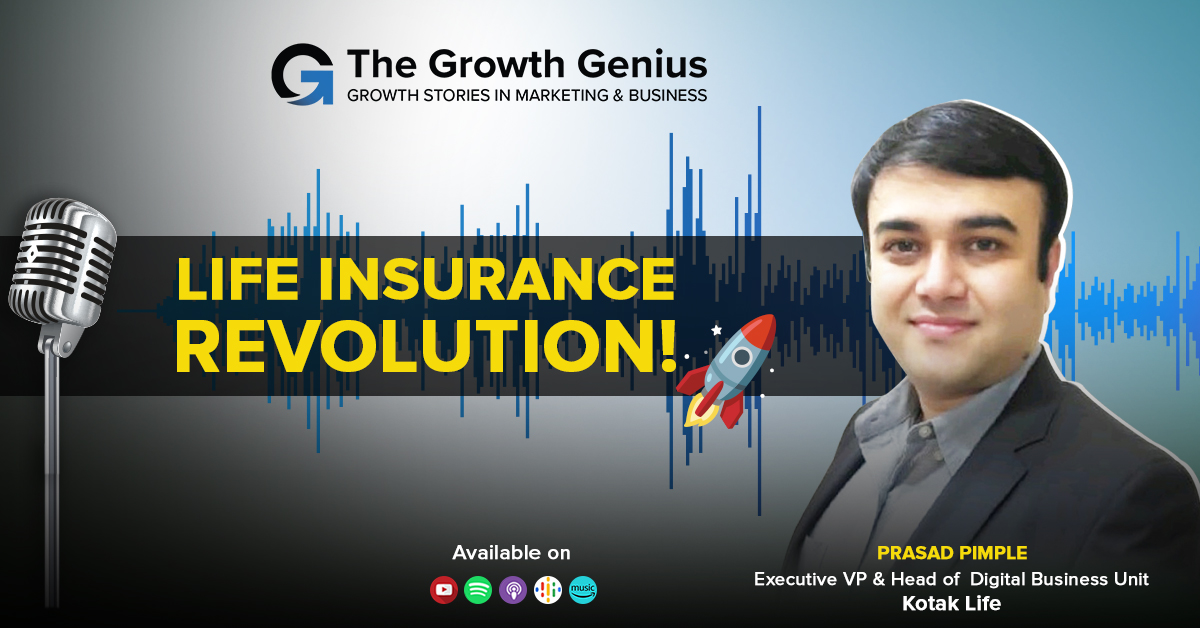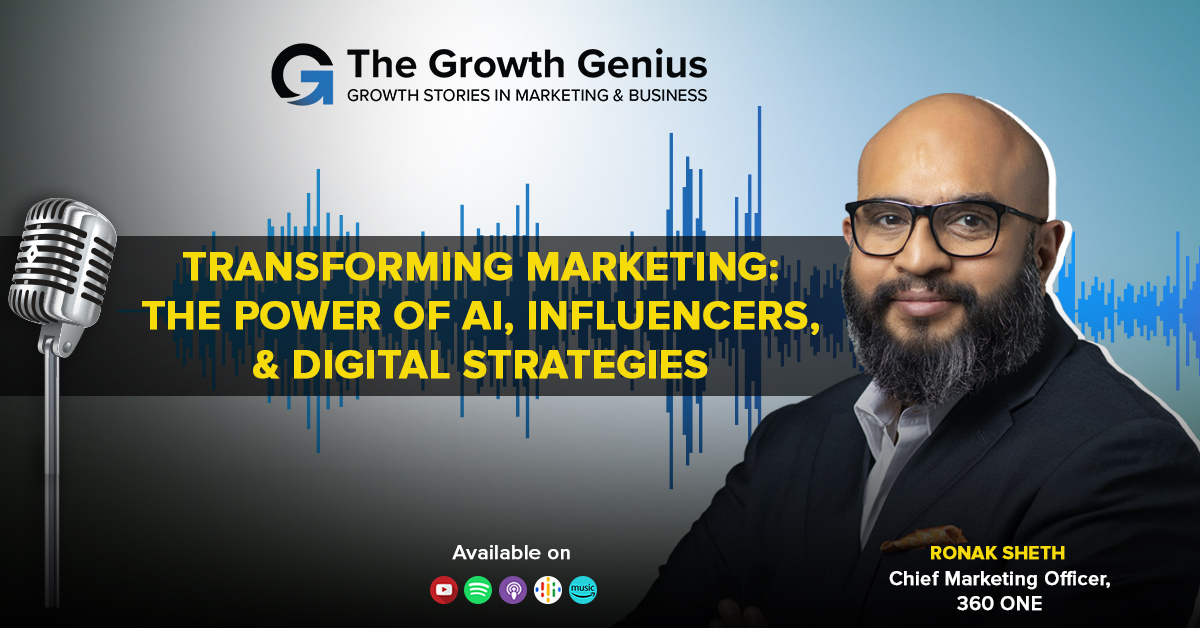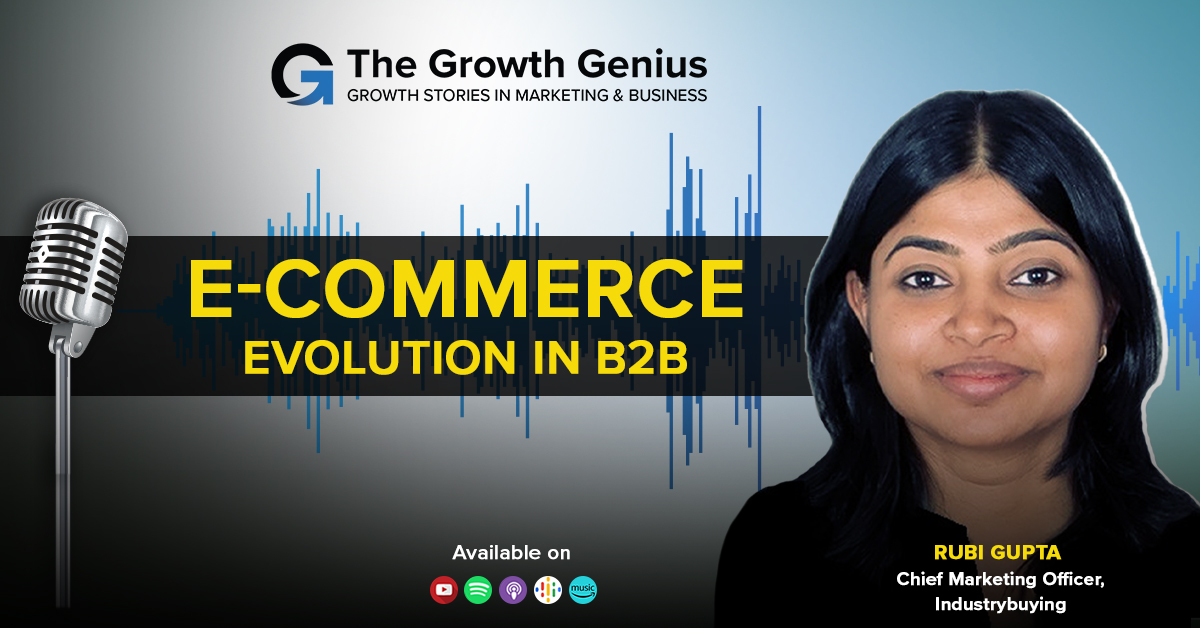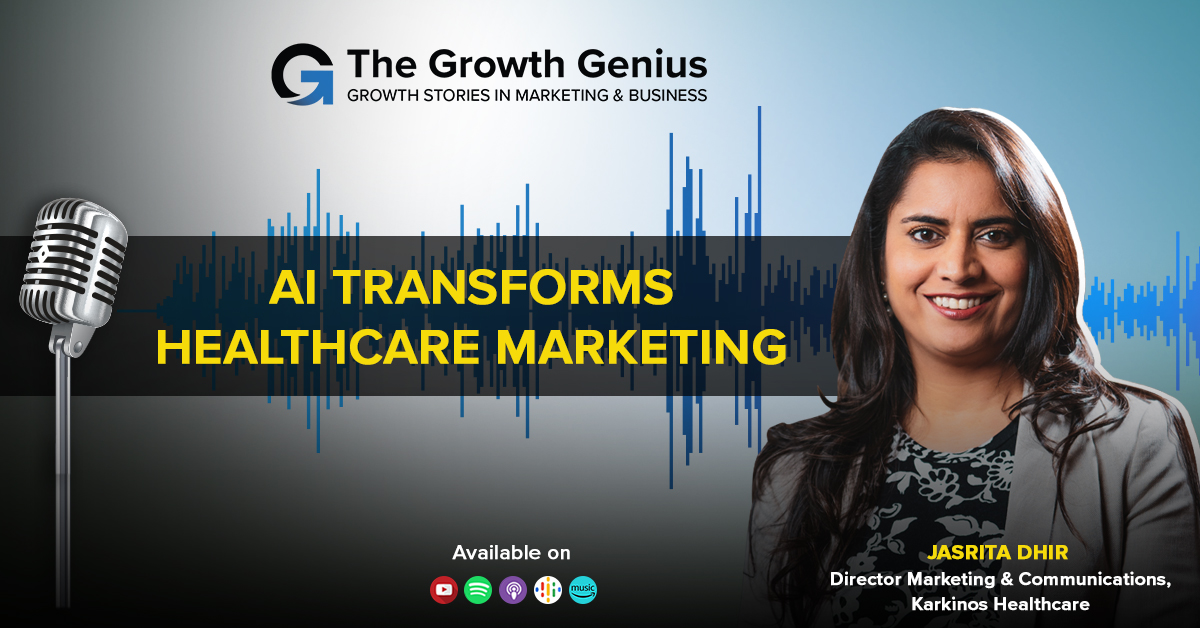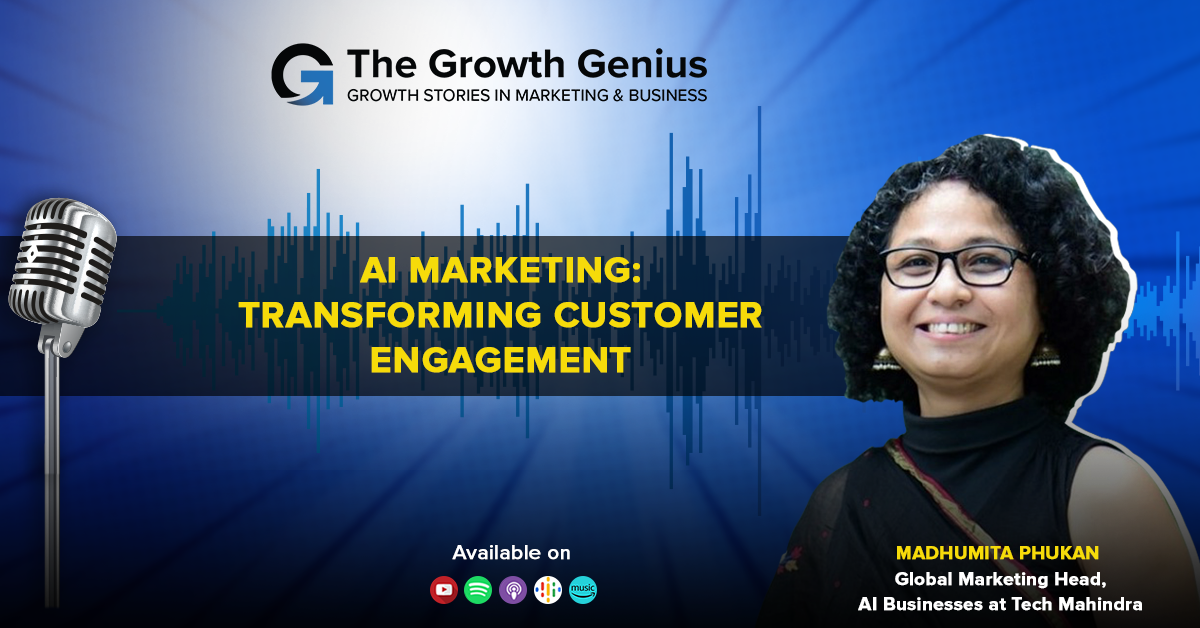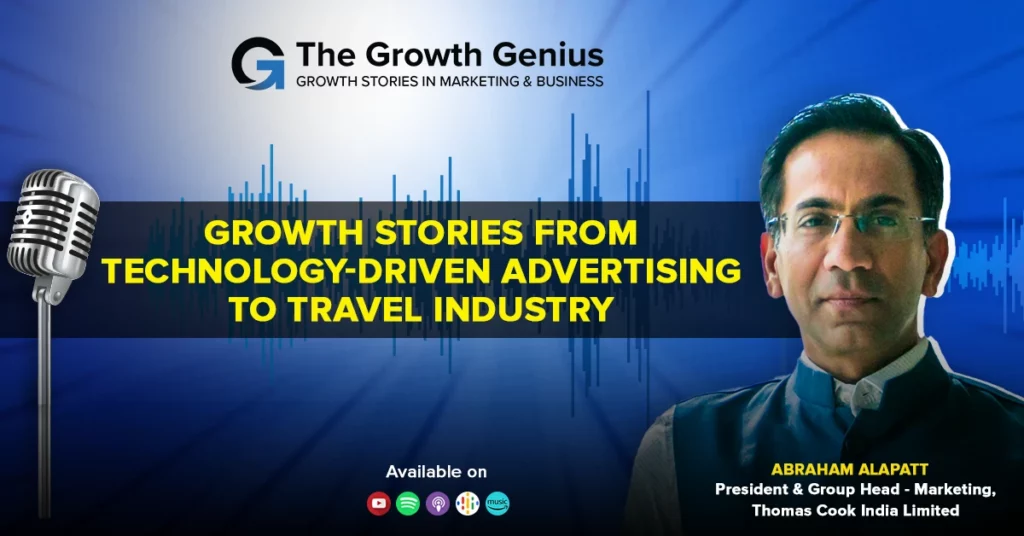
Witness an Increase in your ROI
Unlock higher rankings, quality traffic, and amplified conversions through tailored award-winning SEO strategies.
Listen on your Podcast app
Summary
Dive into the enriching marketing experience of Abraham Alapatt, a narrative that showcases the profound impact of a well-crafted marketing strategy. Alapatt’s journey reflects a fusion of innovative techniques and time-tested methods, resulting in a comprehensive marketing experience. At its core, his approach emphasizes the synergy between digital and traditional strategies, underlining the importance of a holistic marketing strategy. Through a strategic blend of local SEO, community engagement, and adaptive tactics, Alapatt has carved a unique path to success. His narrative serves as a testament to the transformative power of a dynamic marketing experience, offering invaluable insights for businesses striving to create impactful connections and thrive in today’s competitive landscape.
Key Take Aways
- Holistic Approach: Embrace a comprehensive strategy that integrates traditional and digital marketing to maximize brand impact.
- Customer-Centricity: Prioritize understanding and addressing customer needs to build lasting relationships and loyalty.
- Data-Driven Insights: Leverage data analytics to make informed decisions and optimize marketing campaigns effectively.
- Adaptation and Innovation: Stay agile and open to evolving trends, consistently adapting strategies to meet changing market dynamics.
- Storytelling Power: Utilize compelling storytelling to create emotional connections that resonate with the audience.
- Collaborative Leadership: Foster cross-functional collaboration to align marketing efforts with broader business goals.
Read Transcript
Abraham Alapatt: – Marketing is a cumulative experience. You don’t just create demand and bring the customer, but you also ensure that the customer experience is optimized. Innovation is really about incubating new ideas, new businesses, new services given, new products, et cetera an interesting 42% of them said AI has the potential to end or destroy mankind in five to eight years. So that was the doomsday prediction at one end.
Mehul Ashar: – Hi, I’m Mehul Ashar. I am the Senior Vice President – Revenue at Infidigit. Welcome back to The Growth Genius where we discuss stories in business and marketing. In this episode of season three, we have a Growth Genius who has donned multiple roles in different industries starting from advertising to banking, asset management company, an insurance company and now heading marketing for India’s largest integrated travel services group, Mr. Abraham Alapatt, welcome to The Growth Genius. It’s a delight to have you on our show and thanks a lot for taking out time to join us.
Abraham: – Thank you very much for having me.
Mehul: – Great. So, your role is actually a multiple of lot of things. So, I would request you to elaborate a little bit about your role at the Thomas Cook Group.
Abraham: – You’re right, there are a variety of what I would call complementary roles that play at Thomas Cook. Thomas Cook India is a group. We are an Indian conglomerate that has made various acquisitions and grown multinational in its own right since 2012 when we were acquired by Fafax Financial Holdings of Canada. So today Thomas Cook India Day Group is in 25 countries across five continents. So, my role started off as the Head of Marketing. That’s what I was initially called into in 2012 when I joined. After that, a variety of complementary roles that were given to me or I took over because I saw the need for some change or opportunity. The first was service quality, which is our way of saying customer service or customer experience. So obviously I see that as being related to marketing because increasingly marketing in the world what they call the Customer…Chief Customer Officer, in many companies already the Chief Marketing Officer is being called the Chief Customer Officer. So that was a natural fit in terms of saying, listen, marketing is a cumulative experience. You don’t just create demand and bring the customer, but you also ensure that the customer experience is optimized. So, service quality was the next thing that came under my portfolio. The third was innovation. This was a natural extension again of the marketing and customer service or customer experience role. It is really about looking at new opportunities and areas of innovation which are about opportunities of revenue, of improving customer experience, et cetera. So essentially, if you will, creating a spirit of entrepreneurship within an entrepreneurial environment. So, innovation is really about incubating new ideas, new businesses, new services given, new products, et cetera, and sort of try to keep us up to speed with a lot of what’s changing in the environment outside. So that’s the innovation part. And the last part is as Head of Value-Added Services, this is really a bit of business because these are ancillary services to the core travel product, whether it’s B2C or B2B. I also under value added services started independent distribution network we call the TBA network or Travel Business Associate network, which is basically a freelance network. So that’s trying to create entrepreneurs out of freelancers or part timers who may be part time to the travel industry and foreign exchange industry to actually sell our products and services to their customers, who maybe they may be serving in their other business areas. So, these are broadly the roles that play. I see them all as being complementary in a way because it is about the customer at the root of it, it’s about attracting the customer, convincing the customer, selling to the customer, serving the customer, and then ensuring after sales service in a way as well. The other end is about innovating thinking about new propositions, new ideas that will help us get more customers and hopefully serve them better.
Mehul: – Interesting. So, in such a big conglomerate, you still try to create a culture of a start-up, in a sense, or a culture of entrepreneurship, which actually helps to generate new ideas, right?
Abraham: – Absolutely. I think it’s critical as you get bigger, to constantly keep that spirit of thinking of what’s new. Is there an opportunity, is there a tie up, a partnership, or an opportunity to even an acquisition? All those are good corollaries and a good thing to have, irrespective of how big you are. In fact, the bigger you are, I think the more you need it.
Mehul: – That’s interesting. Abraham rather, our viewers will also want to understand how has been your journey as a professional across various industries. I mean, you started with advertising and then today you are with travel. So, take us through your experiences as a professional.
Abraham: – Sure. So, I think right from early on I was fairly clear that I wanted to be in advertising/marketing. I was fairly good at communication, written and oral, so it was fairly natural to think about it as an affinity related sort of career choice. On the converse, I was very bad at math, so that took care of engineering and I probably fainted by people also medicine. So clearly my natural sort of gravity, if you will, was pulling me towards the communication/marketing space, which is why I chose to while I did a BCom initially, I chose to then do a marketing and international marketing MBA. And right through that, I was fairly clear my first job was to be in advertising, which is how I got my first break. And that was entirely by happenstance. I was on leave in Chennai during the MBA course, and somebody called me and said, this agency in Chennai is recruiting, so why don’t you go? And I was on way en route to a film, but I popped in and I didn’t really expect to get the job, but I got employed immediately. It was Chennai’s largest independent ad agency, a breakaway from the task called Goldwire. And I joined probably Goldwire at the right time because Aubrey Siqueira was the Founder, he passed away a few years ago but he was a visionary in his own right, way ahead in terms of technology, so he quickly took Goldwire out of technology. So, we were among the first to get into web solutions and ecommerce and I’m talking about 1995, so this is pretty much ecom boom one. We are still talking about dial in IPS and modems. That’s the era I’m talking about. But Aubrey was very farsighted in that he saw the early opportunity in terms of outsourcing and backend operations from India to serve a global client. So, I was taken from advertising business where I had already worked for a few years and made the CEO of it. Prior to that my first client was MRF in the advertising side, MRF was a fantastic learning experience because they’re one of the toughest advertising clients you can have. So taught me a lot. So that probably set the foundation. After that I was made the CEO of Goldwire Soft Web which is a web solutions business with the backend in India and I was given the task of setting up the international operations. So fairly young at the age, but I went to Singapore, Frankfurt, and San Jose to set up the marketing offices there, recruited locals and so on. So basically, that was the model. So, we had a backend development team in Chennai and these offices with locals actually fronted to sell to clients. So that gave me an early exposure to technology which to a large extent I’ve always been interested in since then. So that’s really helped me in the journey as well. After that things moved on. Goldwire Soft Web had some challenges financially, so I wanted to get back to advertising hardcore and of course Ogilvy was a dream. And so, when I got a chance to join Ogilvy, I did in 2000. So, between 2000 and 2005 I joined Ogilvy as an Account Supervisor, less than five years later as Client Services Director. So that was again a fantastic opportunity because exposure to multiple clients, the Ogilvy way of thinking, creative thinking, which is very right brain versus the traditional left-brain approach to most things. So, I think that was a fantastic sort of paradigm shift both mentally and professionally. Ogilvy, great experience, culture and so on. But by then having spent ten years in advertising and advertising related businesses, I felt it was time for me to become clients for history and move to become a marketer. So, I was going to move to Mumbai with Ogilvy to start Ogilvy second agency, which is when I got an opportunity to meet with Reliance which had just split up the two brothers and Anil Ambani had set up Reliance Capital. So, I was given the opportunity to be the CMO of Reliance Mutual Fund. So, you’ll appreciate it as a shift to marketer, shift to Mumbai and shift to Reliance. But again, fantastic learning opportunity. The group was growing really fast. Reliance Capital was going through the roof. We went from number twelve player with an AUM of about 12,000 crores to in two years becoming number one with over 100,000 crores of AUM and becoming the number one mutual fund in India. So fantastic experience along the way launched some of India’s biggest NFOs. In fact, created the first television commercial for an NFO in India and so on. So again, fantastic learning opportunity. Then I did a short stint at DCB. It was very short. I thought DCB was interesting because they had very ambitious growth plans and I was keen to see what you can do with a small unknown brand like DCV. But unfortunately, there were some RBI related issues that they had in terms of the expansion not getting approved, which is when the opportunity future generally happened. Future Generali was really the coming together of Future Group of India and generally Italy to create a Life and General Insurance integrated insurance model. So, I was made the CMO for both Life and General and I spent first five years there. And then in 2012 I met Madhavan, who’s the chairman of Thomas Cook and we had a short chat over coffee, and he asked me to join and that’s why I joined here. So here of course it’s been an incredible journey since 2012. We acquired a company every year from 2013 onwards to the Pandemic. So, we’ve grown, as I said, from being an India based middling organization to India’s largest integrated travel services company. Like I said, 25 countries, five continents.
Mehul: – That’s quite a journey. In fact, one leaf, one of lesson one can pick out from your advertising journey is when you mentioned about MRF being a taskmaster or working on multiple clients at Ogilvy. If you can share your learnings in terms of how you were able to manage such difficult clients during your stint in advertising?
Abraham: – To me I think there are two things. I’m thinking about it in hindsight of course, to my mind I think there were two things. One was I think I was very determined not to give in. Though there are obviously tough times, especially the early days when you don’t have a mental mentality when the pressure is too high. But I think two things, one, I was determined to learn and get better. Two is that I think I have a fair degree of empathy. So, you sort of get absorbed in it as the client’s business is your business. I think that’s an invaluable skill, if you will, that you need to have as a good marketer or advertiser which is to start really getting into the client’s business and problem. Because only if you see it from the client’s point of view can you really think of a solution or really come up with something that they can also see the value. If you just look at it from, I’m in the advertising business and the solution to whatever problem you have is my 32nd commercial, which is how, unfortunately, a lot of traditional advertising agencies used to operate. I don’t think most clients see the value in that increasingly. So, I think the sense is that what a lot of these tough marketers’ clients needed and probably resonated with was the sense that you are willing to roll up your sleeves and understand the problem. And sometimes the solution was not an advertising solution at all. Advertising could have been part of it but not solved problem. And I think most clients saw the value of you participating in journeys that were to do beyond advertising, which was about fixing distribution problems, which was about understanding if pricing was right, trying to figure out if something the competitor was doing was what was the problem and not what you were doing and so on. So yeah, I think that’s really what I think really worked because that interested me. Willingness to go beyond advertising.
Mehul: – Interesting. So, you have this eclectic mix of being in advertising and at the same time getting exposure to technology very early on because of your earlier stint in Chennai. So how do you feel in terms of the transition of mainland advertising has been over the years with more and more adoption of technology. What are your views on that?
Abraham: – See, I’m happy in a way because I represent the generation that wasn’t born into technology but had to adopt it pretty much early on. In fact, right through my career because I joined Goldwire, and this is where really luck and happenstance happen. Because Goldwire itself was so tech advanced for its time. It was the first agency where at that time you marked attendance on a computer and in those days, even Ogilvy five years later when I joined, you didn’t really mark attendance on a computer, and you briefed on a computer. They had some system which sent jobs to various people in the agency, everything. In 1995, I’m talking about character user interface, CUI versus GUI interfaces, I’m talking about pre-Windows 95. So, imagine in those days they built a platform that could actually do this. Five years later I joined Ogilvy, a multinational and they didn’t have a system like this. So, I had the advantage of working in each of these instances with companies that were pretty big on technology. And as I said, I was lucky to be given the opportunity to lead the .com solutions business early on. So, I think because I had to learn it because it was my professional need to think. For example, one of my early pitches at Goldwire was to somebody who was on the board of NASSCOM. So, I have zero technical education and understanding. And on a more lighter note, in ten minutes into the presentation the gentleman actually said you don’t really have a technical background, do you? So, it was very obvious I didn’t. But I think the good part is simply having to sell technology-based solutions to people who are on the bleeding edge of technology really makes you very competent, very fast. And I think that really helped. And again, right through the advertising space and then into marketing. Technology has played an increasing role every year, so it’s incremental. So, you sort of seep into it. It’s not like one big change that you sort of encounter one fine day. So, I think to that extent I’m more comfortable with what technology and how big technology is today in a marketer’s life versus a lot of my peers because I was exposed to it. Today, I think every market is probably equally a technology.
Mehul: – How has that changed the role of a marketeer today? Starting from mainland advertising to technologically advanced solutions that we have to create different marketing strategies, how has the role changed, according to you?
Abraham: – I think in two fundamental ways. One, I think the whole black box idea, intuition, gut feel thing has been stripped a bit. It’s become more data, it’s become more granularity, it’s become more statistical. And to that extent, you can say there’s a bit of the magic is gone because some of the sort of aura around great ideas which you really couldn’t put your there was no data to back it, but you knew it was a great campaign or a great the results showed. But today you need to be able to make a business case. You need to be able to there’s a lot more analysis and numbers behind what is finally a product that end customers may see, but there’s a lot of data branching and statistical modelling and targeting and things like that. Also, the media environments got a lot more complex earlier. First you had to be one television channel, then you got about ten or twelve, and then you had about 100. But you knew these were the top-rated programs. Prime time was defined. If you advertised, you knew how many people were watching. Print, of course, was even more focused. You knew an exact readership, you knew it state wise, town wise and so on. Today there’s a lot more complexity, but at the same time, like you said, there’s a lot more data and tools to help you target and segment. So, the complexity has increased. It’s not so simple, but again, your ability to sharpshoot versus pray and pray and at the same time measure, analyze, change and Tweak has also improved dramatically, also gives you a lot of opportunity to innovate because there really is nothing you cannot do. There’s always going to be a solution to whatever idea you have. And you can look for people who are looking for you, or your category at least, which is very different from sort of reaching everybody irrespective of whether they’re looking for you and then trying to hope they’re in the mood to reach out to you. So, I think all those things are fundamentally different, but it’s challenging, nevertheless.
Mehul: – Right? Leap to the future, but at the same time, somewhere we are more data driven. Now, as far as the approach.
Abraham: – I think the only thing that the funds remain the same in the sense that clarity. In fact, the whole conversation about brevity and the ability to sharpen what you’re trying to say so that you can engage and convey in a shortest time span, because I think that’s become the biggest challenge in the digital customer age, which is the attention span is considerably reduced, because 30 seconds earlier, it’s four or 5 seconds now. So that’s to a marketer that’s even more challenging to engage enough to get their attention, enough to actually watch, possibly a longer message without knowing that you have to capture their attention in less than 5 seconds.
Mehul: – Yeah, that’s interesting. Now, since you mentioned about tools, what is your take on AI? And are you adopting any AI tools to reach out to your consumers?
Abraham: – Okay, so I was watching an interesting program yesterday on CNN where they were talking about a survey, they did with some of the top CEOs across the largest companies in the world. And an interesting 42% of them said AI has the potential to end or destroy mankind in five to eight years. So that was the doomsday prediction at one end. But 42% is a big number, so just keep that in mind. But what almost all of them said was that AI is definitely going to change the ground rules ball game completely. So, I think nobody will debate that AI is a big game changer. AI is so pervasive already. Probably a lot of us don’t even realize that almost everything that we’re using today, what we call daily electronics has a bit of AI in it already. Whether it’s Alexa and Google, which you all know, all our Android phones, phones are already using AI. And if you look at generative AI itself, a lot of everyday applications are already using them, including search and so on. So, what we are doing to your question on what’s our take on it, I think, yeah, no question that everybody will have to adopt it already. AI is being used to build itineraries and travel. AI has already been used to at a business end, has already been used to develop presentations, write scripts and speeches and so on. So, I don’t think you can exist in the world today without using AI, actually. So, what we are doing is right now we’re running two different uses of AI. One is at the chat level, where our chatbot is using foundation of AI, which will then learn from conversations and problems and get better at dealing with customer queries. So, we should be able to handle more online customers, filter them, and more efficiently get them to a point of conversation where it’s a shopper close of sale, where everything else pretty much AI chatbots can able to do that’s where we want to get to. So that’s one part. The second is we are experimenting on a pilot basis with a listening AI chat sort of device which listens to phone calls and conversations, video call and otherwise in multiple languages. Right now, we’ve got English, Hindi, Tamil and Bengali and essentially these will listen to calls and pick up either right phrases or wrong phrases that are pre-programmed and then score the call and then give you a sort of sense of what needs to be improved and what’s going well in spawn. So, this is a great way for us to sort of figure out how to get our sellers to learn how to sell better on the phone. Because a lot of what we do today, the leads actually land up initially with a conversation on the phone and then only if that call goes well does it migrate to the next level of maybe a visitor for website transaction and so on. A lot of these calls sometimes happen when the customer is on the website. So essentially, we realize that the phone call is a crucial sort of call and if a call is managed better and for that you need something that’s able to listen to and pick up data and findings for us at scale. So that’s what we’re using AI to do. And yeah, I think I’m very bullish about it.
Mehul: – Yeah, interestingly you mentioned about AI being able to capture data, multilingualistically, so to say. So, has there been any headway or has there been any indications right now in the pilot project which says that if you have a multilingual communication with the consumers, that actually helps, especially in a diverse country like India.
Abraham: – Even without AI, we had already realized that for two reasons? One, a lot of our business, like I said, is phone assisted. It’s either a lot of it at the call centre, for example, driven on the phone and then we send them a quotation and a payment link and form. A lot of customers are more comfortable that way. So, definitely somebody who speaks, if not fluently in the local language, at least a mixture of Hindi as a local language or English in the local language is an advantage because customers feel more comfortable that way. We also have a video calling platform which in some ways stimulates the conversation a lot more and is closer to our in-store experience. Gives also the customer a more personal experience. Even there we found that having customers that speak Tamil to selling to a Tamilian, Malayalam to a Malayali, et cetera definitely works better. The resonance, the empathy, the ability to convince the trust. Fundamentally you can feel the trust is much greater when the two speak the same language. So, for sure regionalization is going to be a big thing if you look at India going forward. Right, can’t agree more on that now since we have the Pandemic in the past. How has the travel industry changed post Pandemic? And what is your outlook towards the industry? I think the Pandemic was obviously a hero to zero moment, went from 100 to more revenue literally overnight. For the first time in our lifetimes as marketers, we saw not just no brand demand, we saw no category demand, meaning it’s the kind of scenario nobody ever expects to have. So, I think it taught us more, at least personally taught me more in two years than I learned in 20 years preceding it. So, we did a lot of interesting things through the Pandemic. I think we did them right in hindsight. We did a habit of right sizing, cost optimization, accelerated a lot of technology initiatives. I think a lot of that and including from a marketing standpoint, did things like did a safe travel program in partnership with Apollo Clinics. These are the kind of things I never envisioned myself doing, talking to a hospital, saying to build a safety program for travellers to start traveling again. We did a whole lot of things, but I think a lot of that has worked well for us because we’ve come out of the Pandemic very strong. A lot of our smaller competition has folded up, so that’s cleared up the battlefield a bit. Two is that the technology sort of integrations helps compensate for a much lower workforce because we have right size, and the technology is replaced seamlessly. So today we’re able to do more with a lot less, a lot more efficiently, error free and to scale. So as of March 31, we recorded a fantastic set of results. We had the highest EBITDA in a decade and Sterling subsidiary had their highest profits in their entire since inception. So, I think these are strong signs so far. The forward pipeline is looking good as well. So, we are confident of this recipe as well. Going well. Travel is booming, domestic and international, despite inflated air fairs, despite Visa challenges and all that. So, our outlook is very strong about the sector, about India, of course, macroeconomically very strong. Fastest growing, large economy, largest demography in the world. So, I think a lot of things are going right from that point of view and I think we’re positioned well to grow.
Mehul: – Right, can only grow from this point. I guess the industry as well as the economy as we are seeing. We are coming to the last leg of the interview. So wanted to ask you if you can share specific growth stories from your illustrious career, something that pops up into your mind, which has been an AHA moment for you in your career, if you can share that with us.
Abraham: – I think each stage of your career, a lot of what you do is you’re doing for the first time. So, whether there any job shift where you’re learning a new category, for example, the move from advertising to marketing itself is different. Then you’re getting into financial services. Think about it. When I joined Reliance Mutual Fund, I didn’t even know what a mutual fund was. I’d never invested in a mutual fund. So obviously you have to learn what it is. You have to learn the category, you have to learn the market, you have to learn the challenges. And it was a new city and Reliance was setting up, so everything was new. Then you joined DCB, completely different culture, never worked in a bank. You don’t understand a lot of the terms. So, by the time you figure that out, you join insurance company and it’s life and general. So, you have to learn both industries at the same time. And then you join travel, and everything is different again. And then you’re growing at the rate you are. So, you’re learning something new every day. So, I just say that each of these instances, the pandemic again, like I said, I don’t know if you want to call it AHA moment, but every day was a challenge in its own right. First was the challenge of survival. How do you withstand the storm? You didn’t know how long the storm was going to be. Yeah, so I think I wouldn’t want to belittle any of those experiences by saying something else was bigger. But I can only say that as a marketer, one of the great things about marketing in my mind is the fact that there’s always going to be a new challenge and it’s always going to be bigger than the last one.
Mehul: – One more thing I wanted to ask was about the Fairfax India Charitable Foundation. It has been doing such good work of providing dialysis to more than a million people now. So, tell us something more about this foundation and its vision.
Abraham: – Sure. So, this started with Mr. Prem Watsa, who is the CEO and Founder of Fairfax Holdings. He’s off course of Indian origin, based in Canada, but Indian origin, IIT Madras and so on. So Prem was visiting India in 2016 and he had a meeting with the honourable Prime Minister. And Prem was very keen to figure out a way for Fairfax and its many investments in India. Fairfax is one of the largest foreign investors in India, significant investments. Besides Thomas Cook, we also have significant holdings in Bangalore Airport, CSP bank and a host of other companies as well. So Prem had this meeting. He asked the Prime Minister what was the most constructive way that he could sort of give back to the country. And the Prime Minister was very clear about direction. He told him, “Listen, there’s this huge problem with the need for dialysis. We are the diabetes capital of the world and the hypertensive capital of the world. We are adding more CKD patients. CKD is chronic kidney disease patients who need dialysis to stay alive. We are adding them at a frightening pace, and we simply don’t have the dialysis facilities in the country to solve them, especially for the poorer. So, he gave Prem the direction to set up 1000 dialysis machines across the country. So that was a very simple single mandate that was given to Prem of course, at the time, had no idea what it entailed, didn’t know what it cost. Came out, spoke to Madhavan, Madhavan spoke to me. So, I came on as the CEO. We did a lot of homework. We registered a charitable trust, which is called a Five Vaccinated Charitable Foundation in 2016, October, and we realized how big this problem was. Because just to give you some statistics, we need roughly about 300,000 dialysis machines to serve CKD patients. Today we have less than 30,000. So, we have about 1/10th the machines we need. To make things worse, almost all these machines are located in the richer urban areas. More than 50% of the patients are not in the urban areas. And most of these are in private sector providers who obviously are there for profit. So, the poor are out of the rest. So, what we did was really start focusing on raising the funds and resources to start dialysis centres in the parts where there was no dialysis at all northeast of the case in point. So, what we’ve done very successfully is tied up with the central government at one level with an umbrella agreement, and then multiple state governments under mother agreement. So, we today bring public sector participation with identification of land building, et cetera, to set up a dialysis center, which the government provides. We issue a tender for a private dialysis service provider to operate the dialysis center professionally for five years. And we come in then to raise the funds and deploy a dialysis machine on a free to use basis. So essentially, we raise CSR funds to fund the machine with a comprehensive warranty. The private player comes in to run the center like they are good at doing, and the government provides the infrastructure. So, this is really harnessing the best that each of these three parties can bring to the table. So today, happy to say that the original target was 1000. We are at 1130 almost across 27 OD states across the country. So, we are all the way from Jammu and Kashmir at the top to Tamil Nadu in the south, all the north-eastern states and Gujarat on the left as well. So, we are in almost every state except Punjab, Haryana, and West Bengal, which hopefully we’ll be in shortly. So, we’ve I think, done fairly good work. Most of these BPL patients, which is below the poverty line patients, they just show the BPL five completely free.
Mehul: – That’s an amazing initiative. Last question, Abraham, was for me, the talk was pretty insightful. I could understand certain takeaways that I could gather was there is resilience, there is empathy in terms of understanding the other person’s point of view, openness to learning, et cetera. But I would request you to put it in your words, few takeaways for budding professionals so they can take a leaf or two from your learnings in your career.
Abraham: – I think the first one is going to be a bit contraindicative. I can’t say a lot of what I did was pre planned. So, it’s a combination of luck of fortune or destiny or whatever you want to call it, and a lot of goodwill. So, a lot of people have contributed to giving me the right opportunity at the right time and sort of trusting me to sort of be the right person for it and taking big leap of faith. And I used the example of Ajay Kara wanting me to be the CMO for alliance mutual fund, knowing fully well that I knew nothing about mutual funds, never been invested in mutual fund or something like this, or life in general insurance, knowing that I’ve never done anything in insurance. So, each of these instances are about people posting trust. I’m very grateful for that. I don’t think it’s anything great. I did. I think it’s great on that part to actually give you the confidence. And that, in a way, makes you feel that you have to deliver. Because when somebody tells you, I think you can do it, and then actually puts you in the spot, you can either let them down or live up to it. And I think most people will do their best to live up to it. The only word of advice I give young people is that don’t give up easy. It’s very easy to give up and you always suggesting that something else going to come your way. But I think there is definitely satisfaction and immense learning in not giving up. And two is I think the other thing I’ll always try to hold true to is constantly learning. My favourite quote is he who knows most knows best of it he knows. Which essentially underlines the fact that you never know all there is to know you can never know. So always be humble and always be willing to learn from whoever.
Mehul: – Great. Thanks. I think that has been a very insightful discussion. Abraham, thanks a lot for your time and apologies for the little bit of glitch that we had. Thanks a lot for your patience.
Abraham: – Not at all, not at all. Patience we just spoke of, right? So, I had to demonstrate.
Mehul: – Thank you. Thank you so much.
Abraham: – Thank you. Thank you so much. All the best.
Mehul: – Thanks a lot. So, ladies and gentlemen, this was Mr. Abraham Alapatt, our growth genius for this episode. I hope you found this conversation insightful. Personally, for me, I learned a lot from the conversation I had with him. And if you like our content, don’t forget to subscribe to our handle Infidigit on various social media platforms like Facebook, Twitter, LinkedIn, Instagram, and YouTube. Also, you can hear to this content on various audio streaming platforms, be it Spotify, Apple, or Amazon. We are providing the links to all of this in the descriptor below. So don’t forget to subscribe, like, and share. Until the next episode of The Growth Genius, take care and thank you very much for joining us.


